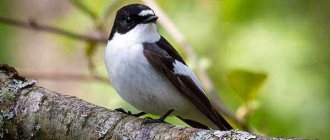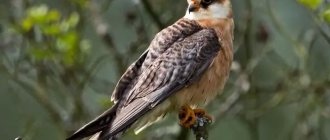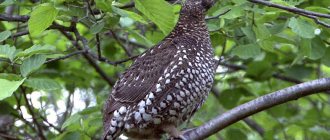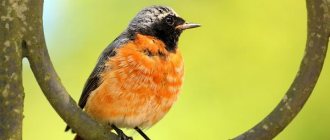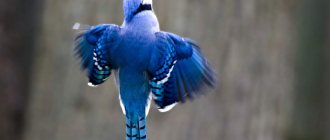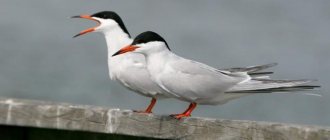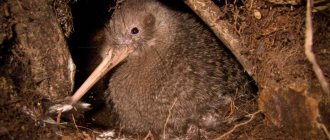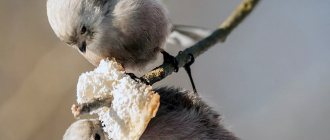- Wild animals
- >>
- Birds
With all her important appearance the bird secretary shows that she occupies, indeed, a respectable and necessary position, and her black and white attire matches the office dress code. This African bird of prey has won the respect of local residents thanks to its food preferences, because the bird eats a huge variety of snakes. Let us characterize this unusual predator by studying its habits, external features, disposition and places of permanent deployment.
Origin of the species and description
Photo: Secretary Bird
The secretary bird belongs to the hawk-like order and the secretary family of the same name, of which it is the only representative. It owes its name to its unusual appearance and characteristic habits. The bird loves to stride sedately and shake its black feathers located on the back of its head, showing its significance and importance. These black feathers are very similar to the goose feathers that, as we know from history, court secretaries inserted into their wigs.
Video: Bird Secretary
In addition to its extraordinary external features, the bird has become famous as an inexorable fighter of snakes. Because of this, Africans treat the secretary bird with great respect; it even serves as decoration on the coats of arms of states such as South Africa and Sudan. The bird is depicted with large wings spread wide, which symbolize the protection of the country and the superiority of the African people over all kinds of ill-wishers. The first to describe the secretary's bird was the French doctor, zoologist, and naturalist Johann Hermann back in 1783.
In addition to the secretary, this bird has other nicknames:
- herald;
- hypogeron;
- snake eater
The dimensions of the secretary bird are quite impressive for birds; its body reaches a length of one and a half meters, and its weight is not that large - about four kilograms. But the span of its wings is amazing - it goes beyond two meters in length.
Interesting fact: There is another version of the origin of the bird's name, different from the one described above. Some believe that the bird was so named by French colonists who heard the Arabic name for “hunter bird”, which sounds like “sakr-e-tair” and called it in French “secrétaire”, which translated means “secretary”.
Description of the bird
The bird's body length is from 125 to 155 cm, weight reaches 4 kg. The wingspan is about 210 cm. A characteristic external difference from other birds is the black feathers on the head, which rise during the nesting period.
In general, the appearance of the bird is very unusual. She has a small head, a gray-white beak, a long neck, and a powerful body, like that of an eagle. The secretary bird is distinguished by its very long legs, which end in short toes with blunt claws. This makes the bird look like it is walking on stilts.
The plumage of the secretary bird in the neck and belly is gray, which becomes darker closer to the tail. There are no feathers around the eyes and up to the beak, and orange skin is noticeable.
Appearance and features
Photo: Secretary bird in nature
The secretary bird is distinguished not only by its rather large size, but also by its entire appearance, which is unlike anyone else. Except that sometimes they are confused with herons or cranes, and even then, from afar, up close they are not at all similar. The coloring of the secretary bird is rather restrained; you won’t see any variety of colors here. The tones are predominantly gray and white, and the closer to the tail part, the darker the background becomes, turning into a completely black shade. Black edging adorns the powerful wings of the secretaries, and black feather trousers are visible on the legs.
The proportions of the bird’s body are quite unusual: you can notice large, powerful wings and long, stilt-like legs, like those of the model. Without a sufficient run, the bird cannot take off, so it runs decently, reaching a speed of more than thirty kilometers per hour. Wings of such enormous size make it possible to silently soar in height, as if freezing in airspace.
Compared to the body, the head of these birds is not too large. The area around the eyes is colored orange, but this is not because of the feathers, but because they are completely absent in that place, so the reddish-orange skin is visible. The bird has a fairly long neck, which it often arches importantly. Large beautiful eyes and a hook-shaped beak indicate its predatory nature.
Interesting fact: The long black feathers at the back of the head, which are the calling card of secretary birds, can give away the males, because during the wedding season they are raised upright.
The long and slender limbs of the secretary bird have rather short fingers, which are equipped with very hard, massive, blunt claws. The birds successfully use them as weapons when fighting snakes. It should be noted that such bird weapons operate flawlessly, giving a huge advantage over creeping ones.
What does it eat?
The secretary is such a glutton! They will not refuse amphibians, lizards and small birds. Even frogs and turtles serve as food for them. The most delicious dish for secretary birds is snakes. Fighting snakes is common for secretaries. When attacking, the bird spreads one wing, which serves as a shield.
The secretary bird caught another snake.
The secretary ends the fight with a fatal blow to the spine. Dinner is served!
Where does the secretary bird live?
Photo: Secretary bird from the Red Book
The secretary bird is an exclusively African resident and is endemic to this hot continent. It is impossible to meet her anywhere else except Africa. The bird's habitat extends from Senegal, reaching Somalia, then covers territories a little to the south, ending with the southernmost point - the Cape of Good Hope.
The secretary avoids wooded areas and desert areas. Here it is inconvenient for him to hunt, the forest blocks the all-round view from above, and the bird silently soars, inspecting the surroundings not only to detect a snack, but also to protect its nesting site. In addition, the bird needs sufficient space to take off, without which it is not able to take off, and bushes and trees in the forest interfere with this. Secretaries also don't like the desert climate.
First of all, these mighty birds inhabit spacious savannahs and African meadows; here the territory allows them to run properly, take off, and survey the ground situation from above, skillfully soaring in the skies. The secretary bird tries to stay away from human settlements and cultivated agricultural land to avoid robbing nests, because Local residents make a living by stealing bird eggs, which they eat. So, populations of these birds are rarely found close to human habitations.
Bird distribution
The secretary bird is common in Africa, where its habitat stretches from the south of the Sahara to South Africa. For life, the predator chooses steppes and forest-steppes - savannas, which are located in the southern regions of Sudan and Senegal up to the Cape Province.
Secretary populations that live in the south of the continent lead a sedentary lifestyle. Residents of the north are migratory birds. They live in their native places in June, during the rainy season, then hatch their chicks in August, and from December to January, when drought sets in, they fly south.
Secretary birds rarely settle near people's homes to avoid the destruction of their nests.
What does the secretary bird eat?
Photo: Secretary bird and snake
The secretary's bird can rightfully be called the thunderstorm of all snakes, because slithering ones are its favorite delicacy.
In addition to snakes, the feathered menu consists of:
- small mammals (mice, hares, hedgehogs, mongooses, rats);
- all kinds of insects (scorpions, beetles, mantises, spiders, grasshoppers);
- bird eggs;
- chicks;
- lizards and small turtles.
Interesting fact: Entire legends are formed about the insatiability of secretarial birds. There is a known case where two pairs of lizards, three snakes and 21 small turtles were found simultaneously in a bird's crop.
It should be noted that the secretary bird has perfectly adapted to terrestrial life; it is simply excellent at hunting without leaving the ground. Birds can walk up to thirty kilometers in a day in search of food. The ability to catch even dangerous and poisonous snakes shows the intelligence and courage of the bird.
Snakes, when fighting with a bird, try to inflict their toxic bite on it, but the secretary bravely defends himself, fighting off the attacks of the reptiles with the help of his powerful wings, like large shields. The fight can be quite long, but in the end, a good moment comes when the secretary presses the snake's head with his strong leg and pecks it directly in the head area, which leads to the death of the reptile.
Interesting fact: With the help of long limbs and a powerful beak, the secretary bird easily breaks turtle shells.
Secretary birds have their own hunting techniques that help locate prey. While walking around her land, she begins to make a lot of noise, flapping her huge wings and scaring small animals. Rodents leave their burrows out of fear and try to run away, only to be caught by a cunning bird. The bird can also trample heavily in places where it sees unusual bumps, which also drives rodents to the surface.
During fires that occur in savannah areas, the secretary bird continues to hunt for its meal. When all the animals are running away from the fire, she persistently waits for her small prey in the form of small mammals, which she immediately catches and eats. Having flown over the firing line, the secretary looks for already charred animal carcasses in the ashes, which he also snacks on.
Now you know everything about the secretary bird's hunt for a snake. Let's find out more about the habits of this interesting bird.
Russian name – secretary bird or secretary
Latin name -
Sagittarius serpentarius
English name -
Secretary bird
Class - Birds ( Aves )
Order – Falconiformes
Family – Secretaries ( Sagittariidae )
The only representative of the family, sharply different from all other representatives of the order. There are some signs of its relationship with the South American cariamas (p. Cariama), which are classified as either chickens or cranes.
Conservation status
According to the international classification, the species is included in the “Red Book” in the “vulnerable” section - IUCN (VU). In 1968, it was protected by the African Convention on the Conservation of Nature and Natural Resources. The number of birds decreases with the development and plowing of grassy savannas. In addition, the number of nesting pairs and the frequency of reproduction vary depending on the availability of food supply.
Species and man
In South Africa, the secretary bird is considered noble; its image adorns the coat of arms of the Republic of South Africa (RSA). In this coat of arms, the bird spreads its wings wide, which is supposed to symbolize the superiority of the South African people over all their enemies. In addition, with its outstretched wings, the secretary bird seems to protect the country from various misfortunes.
There is an image of a secretary bird on the coat of arms of another African country - Sudan.
However, there are often cases when people destroy the nests of the secretary bird, and therefore it prefers to settle away from humans.
Distribution and habitats
The secretary bird lives in the northern, eastern and southern regions of Africa. Fossil remains have also been found in Europe. Prefers open savannas and semi-deserts, avoids dense thickets of trees and shrubs, as well as tall grasses.
Appearance
Tall (over 1 m with the head raised up), unusually long-legged bird (tarsus 28-35 cm), more like a crane or stork than a predator (3 toes connected by a barely noticeable membrane). Body length 115-125 cm, weight -3.5-4 kg. Wing length 61-67 cm, span more than 2 m. The central feathers of the tail are 57-85 cm long. The general color of the plumage is white or light gray, the flight feathers, shin feathers, the end of the tail and the feathers of the crest are black. The bare skin on the sides of the head is orange or red. The feet are reddish with wide nail-like claws. There are 10-15 long feathers sticking out on the head, which gives the bird a resemblance to a human clerk with a bunch of feathers tucked behind the ear. That is why the bird got its name, which has been preserved since the end of the 18th century, when the species was first described.
Lifestyle and social behavior
The secretary bird, unlike most birds of prey, spends almost all its time on the ground, walking 20-30 km a day in search of food. In order to take off, the secretary requires a significant run-up. However, during the mating season and nesting, the male periodically hovers over the nest, protecting it from possible enemies.
Outside the nesting period, secretaries lead a nomadic lifestyle, while the pair, which is formed for life, stays together, not letting each other out of sight. The nesting site is fixed and protected by birds only for the nesting period.
Secretary birds spend the night in trees.
Nutrition and feeding behavior
Secretaries feed mainly on locusts, beetles and other large insects, rodents, lizards, and chicks of ground birds. They also catch and eat snakes, including poisonous ones, but not nearly as often as previously thought. Therefore, they do not fully justify their species name serpentarius - “snake hunter”. Food is obtained only on the ground. Small prey is pecked, larger prey, including snakes, are first killed with blows from the paw and beak. The strength of the secretary's legs is such that with one blow he breaks the shell of a small turtle.
When starting a hunt, the secretary bird behaves quite noisily - it beats its wings, thereby forcing the prey to leave the shelter and flee. At this moment she becomes the prey of a predator. The secretary easily catches up with the victim using zigzag movements. To attack, it uses powerful paws and beak, and to protect against the bites of poisonous snakes it covers itself with one wing, like a kind of shield. Having killed the prey, the bird throws it into the air several times to make sure that the prey is dead.
Unlike other animals inhabiting the African savannah, the secretary bird is not only not afraid of fires, but uses them when hunting: either catches animals escaping from the fire, or, having flown over the line of fire, picks up the remains of those killed in the fire. In other cases, the secretary also does not disdain carrion.
Vocalization
The secretary bird is usually quite silent, only during the mating season the male, calling the female, makes croaking and growling sounds.
Reproduction and parental behavior
The breeding time of the secretary bird is determined by the rainy season.
Refers to monogamous species, i.e. Pairs form for life. Mating games take place on the ground (running in a circle, jumping with open wings, nodding, as well as the characteristic calls of the male) and in the air (joint “diving” flights, chasing each other).
Birds make large flat nests (up to 1.5-2.5 m in diameter) on the tops of low trees (acacias, for example) or tall thorny bushes. The tray is lined with bunches of dry grass. The nesting territory is protected from individuals of their own species.
The clutch contains 2-3 bluish-white eggs, incubated only by the female for 45 days. Both parents feed newborn chicks with liquid food, regurgitating semi-digested insects. When grown, adult birds bring prey in the crop and regurgitate it into the nest (as storks do), but then tear it apart for the chicks, like all birds of prey.
Fledglings leave the nest at the age of 70-80 days; if this happens earlier, the parents feed them on the ground.
Lifespan
According to various authors, the life expectancy of secretaries ranges from 12 to 18 years; in captivity, obviously, it can be longer.
The story of life at the Moscow Zoo
A young male secretary bird arrived at the Moscow Zoo in September 2022. He was born in 2015 and not in Africa, but in the Bird Park in southeastern France. In winter, he is kept in one of the internal aviaries of the Bird House, and with the onset of warm days he will walk in the external aviary.
The secretary bird's food in the zoo consists of adult and newborn mice and rat pups. Every day he receives 8 mice, and one day is a fasting day, when the amount of food decreases.
Secretary birds have lived in our zoo before, and in two cases for quite a long time. One – from 1952 to 1968, i.e. 16 years and the second - from 1964 to 1978, i.e. 14 years old.
Features of character and lifestyle
Photo: Secretary Bird
The secretary bird spends most of its time walking on the ground; it can rarely be seen in flight. This usually occurs during the wedding and nesting season. The bird flies excellently, only before the start it needs to accelerate, and it gains altitude gradually, slowly, spreading its mighty wings. Usually the feathered fathers soar in the heights, guarding their nesting sites from above.
Secretary birds can be called faithful and loving, because they create a mate for life. And the life span measured by nature is about 12 years. In watering places and where there is a lot of food, secretaries can form bird groups for a short time. The way of life of these birds can be called nomadic, because in search of food they constantly move to new places, but always return to their nesting place.
Birds hunt on the ground, but prefer to rest and build nests in trees. It should be noted that these birds have excellent ingenuity, because for different types of prey, they have all sorts of tactics. Some of them have already been described, but there are more. For example, when hunting snakes, seeing a creeping one, the bird begins to make clever dashes in different directions, constantly changing the vector of its movement. In this way, she misleads her prey, the snake becomes dizzy from this running around, loses orientation and soon becomes an excellent snack.
In wild conditions, a mature secretary bird tries to avoid communication with humans. Seeing people, she immediately leaves, taking long steps that smoothly turn into running, and then the bird takes off from the ground, rushing upward. The young of these birds are easily tamed and can coexist peacefully with people.
Interesting fact: Africans deliberately breed these birds on their farms so that the secretaries protect poultry from dangerous snakes and catch harmful rodents.
Nutrition
The secretary bird has adapted better than all its fellow predators to hunting on land. There are legends about the gluttony of these birds. One day, 3 snakes, 4 lizards, and 21 small turtles were found in the secretary's crop. The secretary's menu is varied - from locusts and praying mantises to large poisonous snakes.
By the way, hunting for snakes shows the secretary bird not only as a voracious predator, but also as a very smart hunter. When the bird discovers the snake, it begins to attack, trying to reach the hunter with its poisonous bite.
The secretary repels all the snake's attacks with his open wing, covering himself with it like a shield. Such a duel can continue for quite a long time; in the end, the bird chooses the moment when it deftly presses the snake's head to the ground and kills the enemy with a blow from its powerful beak. By the way, this bird can easily crush a turtle’s shell with its legs and beak.
Secretary bird caught a snake
The secretary has some tricks for catching small and large prey. So, for example, when starting its daily walk around the territory, the bird flaps its wings vigorously and makes a lot of noise, because of which timid rodents jump out of cover and rush away. This is how they give themselves away, but they cannot escape from the fast bird legs.
If the flapping of its wings does not have a frightening effect, the bird can trample a fair amount on suspicious hummocks; no rodent can survive this. Another interesting fact. There are fires in the savannahs, from which everyone hides and runs away - including the victims of the secretary bird.
Because he doesn't run or hide, he hunts at this time. He deftly snatches rodents that are running away from the fire. And after there is no one left to catch, the bird easily flies over the fire line, walks on the scorched earth and eats already burned animals.
Social structure and reproduction
Photo: Secretary bird in flight
The wedding period for secretary birds is directly related to the rainy season, so the specific time of its arrival cannot be named. As already noted, these birds live in married pairs, which are formed for the entire life span of the bird. Feathered gentlemen are true romantics who are ready to court their chosen one, conquering her with a beautiful soaring flight, mating dance, and extravagant song. Performing all these tricks in front of his partner, the male constantly makes sure that no stranger invades his domain, jealously protecting the female.
Coitus most often occurs on the surface of the ground, and sometimes in tree branches. After mating, the future father does not leave his beloved, but shares with her all the hardships of family life, from building the nest to raising the chicks. The nesting nest of the secretary bird is built in the branches of an acacia tree; it looks like a large platform with a two-meter diameter, looks impressive and heavy.
For construction the following are used:
- grass stems;
- manure;
- woolen tufts of animal fur;
- foliage;
- rods, etc.
Interesting fact: Secretaries have been using the same bird's nest for many years, always returning to it during the wedding season.
The clutch of secretary birds contains no more than three eggs, which are pear-shaped and bluish-whitish in color. The incubation period lasts about 45 days, during which time the future father goes hunting alone to feed both himself and his partner. The process of hatching chicks from eggs does not occur simultaneously, but one by one. The earlier the egg was laid, the faster the baby hatches from it. The age difference between chicks can be up to several days. The chances of survival are greater for those who leave the shell first.
The development of secretary chicks is slow. These feathered babies get to their feet only when they are closer to six weeks of age, and when they are 11 weeks old they begin to try to make their first inept flights. Feathered parents tirelessly take care of their babies, first feeding them regurgitated, half-digested meat, gradually moving on to raw meat, which they tear into small pieces with their large beaks.
Lifestyle of a married couple
Both individuals take part in the construction of the nest. The birds make their home, made of branches with a thick layer of grass (dung, wool, etc.) at the bottom and shaped like a platform with a diameter of up to 2.5 meters, usually on the flat top of thorny trees, most often on acacias. Every year, the pair, which never separates and always tries to be within sight of each other, returns to the old nest to breed; They abandon their den only in cases where the mass of the latter becomes dangerously heavy and there is a risk of the nest falling to the ground.
Natural enemies of secretary birds
Photo: Secretary bird in nature
It just so happens that in the natural wild environment, mature secretory birds have practically no enemies. The most vulnerable are the chicks of these birds, which develop very slowly. Crows and African eagle owls can steal chicks from large, open nests. This usually happens when the parents go in search of food.
Do not forget that the babies hatch gradually and those who were first have a greater chance of survival, because they get much more food. It happens that fragile chicks, trying to imitate their parents, jump out of the nests. Then the chances of surviving on the surface of the earth are significantly reduced, because here they can become prey to any predators. Parents still take care of the lost baby, feeding it on the ground, but most often such feathered babies die. The survival statistics for secretary chicks is disappointing - out of three, only one bird usually survives.
Among the enemies of secretary birds can also be considered people who are settling in more and more African territories, displacing birds from their places of permanent deployment. Plowing land, building roads, and grazing livestock also harm birds, forcing them to worry and look for new places to live. Africans sometimes destroy bird nests, taking from them the few eggs they have, which they eat. It’s not for nothing that secretary birds try to stay away from human settlements.
What kind of life does he lead?
These birds, unlike their feathered relatives, do not like to fly. Most often, secretaries hovering in the air can only be seen during the mating season. Their lifestyle resembles a nomadic one: in search of food, birds move from one place to another. And only when mating do they return to the already built nest.
- Scolopendra
- 32 facts about tigers
- Weasel
- Whale shark
- 34 facts about raccoons
- Maned wolf
Birds are very faithful, therefore, once they find their soul mate, they do not betray each other and remain together forever. During the mating season, they do not move further than the field of view of their partner and do not allow rivals to approach each other.
Population and species status
Photo: Secretary Bird
Despite the fact that the inhabitants of Africa revere the secretary bird because it kills a huge number of dangerous snakes and rodents, its population is steadily declining. This is due to various negative factors. Firstly, small clutches of these birds can be included here, because usually the female lays only three eggs, and this is very little. Secondly, the survival rate of chicks is very low; out of three, most often only one lucky one makes the way to life.
This is due not only to the attacks of various birds of prey, but also to the fact that in the arid savannas of the African continent, birds often experience a lack of food, so parents can only feed one child. Often, to feed their young, secretaries kill large prey, the meat of which is saved by tearing off small pieces in order to stretch it over a longer time. They hide the carcass in dense bushes.
In addition to all of the above reasons for the decline in the number of secretary birds, there are other negative factors, mainly of human nature. This is due to the fact that Africans eat the eggs of these birds, destroying their nests. Also, the expansion of spaces occupied by people for their own needs has a bad effect on the size of the bird population, because there are fewer and fewer places left for a calm and serene habitat. As sad as it is to understand, all this has led to the fact that this species of amazing birds is in danger of extinction, and therefore needs protection.
Interesting facts about the bird
- In South Africa, the secretary bird is considered a noble species and is featured on the South African coat of arms, where the bird is depicted with its wings spread, a symbol of the superiority of the South African nation over its enemies. In addition, with his outstretched wings, the secretary protects his country. The image of the secretary bird is also featured on the coat of arms of Sudan.
- During the nesting period, the male carefully guards his territory. The bird attacks any stranger who tries to approach the nest with blows of its strong legs and drives it away.
- To feed the offspring, the secretary hunts for large game, which he uses very sparingly. The bird hides the killed victim under the bushes and returns to it as needed. Due to food shortages in the arid African savannas, secretaries can usually raise only one chick.
- For humans, the secretary bird is useful because it feeds on pests. South African farmers even specifically breed these birds on their farms to protect poultry from snakes and to kill rats. Young secretaries are easy to tame and live freely next to humans.
- In nature, adult secretary birds avoid humans. When approaching a bird, it immediately leaves with large and hasty steps, breaking into a run and then taking off. At first the secretary's flight is difficult, but at high altitude it becomes graceful and soaring.

